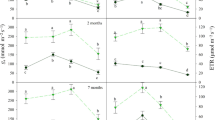Abstract
The photosynthetic characteristics ofCycas micronesica K.D. Hill were studied from August 1998 until February 1999 using chlorophyll fluorescence and gas-exchange techniques to determine the responses to long-term shade of 35% ambient light transmission, followed by the transfer of shade-grown leaves into full-sun conditions. The shade-grown leaves exhibited increased photosynthetic light use efficiency and effective quantum efficiency of photosystem II (PS II) and decreased photosynthetic light saturation point and dark respiration when compared with leaves grown in full sun. Shade was removed from shade-grownC. micronesica leaves during midday on December 14, 1998, when effective quantum efficiency of shaded leaves was 45% greater than that of sun leaves. Following one hour in full sun, effective quantum efficiency of the shade-grown leaves declined to below that of the sun-grown leaves. After receiving full sunlight for the rest of the photoperiod, maximum quantum efficiency of PS II photochemistry for shade-grown leaves was below that of sun-grown leaves throughout the night. The damage caused by excessive light to shade-grown leaves progressed for the first three days after shade removal. On day 3, effective quantum efficiency during midday was 30%, net photosynthesis was 47%, apparent quantum yield was 65%, and light compensation point was 136% of that for sun-grown leaves. After day 3, the relationship between full-sun leaves and the previously shaded leaves for these response variables was relatively stable. Two months following removal of shade, the previously shaded leaves continued to exhibit damage from high light. These results have application to transplanting cycad plants from a shaded nursery to a field site or, after tropical cyclones, where protective forest canopy cover has been destroyed and cycad plants in the forest subcanopy are abruptly exposed to full-sun conditions.
Similar content being viewed by others
Literature Cited
Chabot, B. R. &D. J. Hicks. 1982. The ecology of leaf life spans. Ann. Rev. Ecol. Syst. 13: 229–259.
Hill, K. D. 1994. TheCycas rumphii complex (Cycadaceae) in New Guinea and the Western Pacific. Austral. Syst. Bot. 7: 543–567.
Kisby, G. E., M. Ellison &P. S. Spencer. 1992. Content of the neurotoxins cycasin and BMAA in cycad flour prepared by Guam Chamorros. Neurology 42: 1336–1340.
Kurland, L. T. &D. W. Mulder. 1954. Epidemiologic investigations of amyotrophic lateral sclerosis, 1. Preliminary report on geographic distribution, with special reference to the Mariana Islands, including clinical and pathological considerations. Neurology 4: 355–378, 438–448.
Lugo, A. E. &F. N. Scatena. 1996. Background and catastrophic tree mortality in tropical moist, wet, and rain forests. Biotropica 28: 585–599.
Marier, T. &H. Hirsh. 1998. Guam’sCycas micronesica populations ravaged by Supertyphoon Paka. HortScience 33: 1116–1118.
— &L. E. Willis. 1997. Leaf gas-exchange characteristics of sixteen cycad species. J. Amer. Soc. Hort. Sci. 122: 38–42.
Norstog, K. J. &T. J. Nicholls. 1997. The biology of the cycads. Cornell Univ. Press, Ithaca, NY.
Safford, W. E. 1905. The useful plants of the island of Guam. U.S. National Herbarium, IX. U.S. Government Printing Office, Washington, DC.
Shaw, C. A., J. S. Bains, D. E. Williams, R. J. Andersen, B. A. Pasqualotto, J. Cheung, M. Tjandrawidjaja, M. Wilkinson, R. Janaky &U.-K. Craig. 1999. Identification of a novel excitotoxin from cycad seed: Implications for neuronal disorders. Society for Neuroscience 25: 1304 (abstract).
Stevenson, D. W. 1990. Morphology and systematics of the Cycadales. Mem. New York Bot. Gard. 57: 200–206.
Stone, B. C. 1971. America’s Asiatic flora: The plants of Guam. Amer. Scientist 59: 308–319.
Whiting, M. G. 1963. Toxicity of cycads. Econ. Bot. 17: 271–302.
Young, F. J. 1988. Soil survey of the territory of Guam. U.S. Soil Conservation Service, National Cooperative Soil Survey.
Author information
Authors and Affiliations
Rights and permissions
About this article
Cite this article
Marler, T.E. Leaf physiology of shade-grownCycas micronesica leaves following removal of shade. Bot. Rev 70, 63–71 (2004). https://doi.org/10.1663/0006-8101(2004)070[0063:LPOSCM]2.0.CO;2
Issue Date:
DOI: https://doi.org/10.1663/0006-8101(2004)070[0063:LPOSCM]2.0.CO;2




